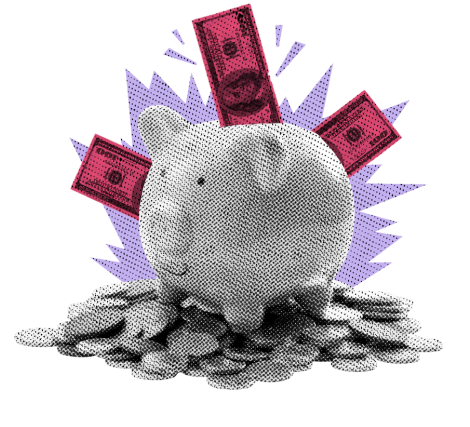
Inflation’s cooling, but consumer spending just shrank. With tariffs hitting and confidence fading, GDP growth may be in trouble. Here’s what you need to know.
KEY TAKEAWAYS
- Inflation is still top of mind, but consumer spending is the real concern.
- The latest GDPNow model predicts a -1.477% contraction after a weak spending report.
- Tariffs on Mexico, Canada, and China are escalating, adding more inflationary pressure.
- Consumer confidence has dropped for three straight months but hasn’t fully hit spending data yet.
- If confidence continues to drop, so will consumption—dragging GDP growth down with it.
MY HOT TAKES
- Inflation is a distraction—consumption is the real story, and it’s showing cracks.
- Tariffs aren’t helping, but the bigger problem is consumer confidence eroding quietly in the background.
- The Fed’s rate path may not matter if consumers stop spending.
- GDP growth just went from “solid” to “at risk” overnight.
- The market’s obsession with inflation is about to shift to growth fears—watch for it.
Tread lightly. What is the first thing that comes to mind when you are thinking about the economy? Inflation? Why not, it has been a top 2 contender for the past few years. And, in reality, things are more expensive than they were last year, and certainly a few years ago. Inflation isn’t good, we don’t like it, the Fed doesn’t like it, revolutions have been ignited because of it, heads—real heads—were removed from bodies… well, you know. The Fed ratchetted up interest rates like it was the 1980s, and stocks got hammered. We dealt with the pain knowing that it was a necessary, bitter pill that needed to be taken to get rid of inflation. The bitterness was only weakened with the hopes of rate cuts that would eventually come. They came…and then they stopped. So, yeah, the market is a bit obsessed with inflation as it impacts our wallets in the real world, and in our portfolio in the market world.
We all know by now that tariffs can be inflationary. Even the President is coming round to that reality. But still, any talk of inflation only inflames the already sore feelings of it. That is probably why we have been so obsessed with topic 2—tariffs, and because the President is so eager to make good on his campaign promises, he has been hitting them hard. I stopped counting the days where we are getting some information or other about tariffs, but rather I have begun to count the days where we don’t hear about them, and there are very few.
Based on everything we know this morning, tariffs on Mexico and Canada will start tomorrow. Commerce Secretary Howard Lutnick implied, over the weekend, that they may not be the full 25% expected, but it sounded pretty clear that some form of tariff will begin tomorrow. Also tomorrow, may be another 10% levied on China bringing total tariffs up to 20%. Further, in the news this weekend, China promised to hurl counter-tariffs on the US, including commodities (not good, if you remember last time). Does all this have you worried about what the Fed will do next?
Well, first let me say that Friday’s PCE Price Index, the Fed’s favorite inflation gauge, showed that inflation moderated somewhat last month, as economists were expecting. If you dig into the numbers, the culprits for sticky inflation are still housing and insurance. These fall under services. Housing inflation has let up somewhat, but at a slow pace, but at least it is not going up. What did contribute to last month's number was food inflation. The good news there, if you can call it that, is that food inflation is normal. Food prices are always volatile and largely under the control of mother nature—weather and disease. That comes and goes, although now it hits a bit harder. That said, all the recent inflation numbers suggest that there is a world where inflation can return to normal (2% according to the Fed) in the near term.
So, is that it? Nothing to worry about anymore? Unfortunately, folks, there is plenty to worry about—if not inflation. You all know that I am obsessed with consumption. Go on, repeat my mantra. I literally said it on national television 3 times in the last three days. Consumption makes up 2/3 of GDP, so it’s important. Well, you may have missed one of Friday’s numbers in the midst of the non-event PCE Index release, and the Zelensky smackdown in the oval office. That number to which I refer is the Personal Spending number for January. It plugs right into the GDP equation… you know, that part I always talk about--consumption.😉 It came in with a monthly decline of -0.2% when economists were expecting a pickup of 0.2%.
That may not seem like much, but, unfortunately, it is—much, that is. The Atlanta Fed runs a model called GDPNow, in which they do some fancy statistics (not really that fancy to be honest) to try and predict what the GDP will be this quarter. Remember, we won’t know until April 30th. This Nowcast is the result of a regression in which GDP is the dependent variable and the factors are the independent variables which explain changes in GDP. That said, one of those is, as you might imagine, personal CONSUMPTION. Well, last Friday’s number caused the Nowcast to predict a decline of -1.477%. That’s right an economic contraction! I am sure that I don’t have to tell you that a contraction is not good when it comes to GDP. The prediction prior to Friday’s number was around 2.3%, which is solid. I was in line with the consensus of Blue Chip economists, and unchanged from Q4. Respectable, indeed. Check out the following chart then follow me to the finish.

The model prediction is the olive-green line on the right-hand side of the chart. Pretty stark, eh? And what do you think caused this sharp decline in consumption in January? Well, if we look at Conference Board Consumer Confidence in January, it logged its second monthly decline, falling to 105.3 from 109.5. That’s right consumer confidence began to wane. When you are worried about your financial prospects, you cut back on spending… I hope. You got it? Confidence down leads to spending down, which leads to lower or negative GDP growth. Do you remember that we got February’s Consumer Confidence number earlier last week? It registered a third straight decline to 98.334. That’s a pretty sizable drop. But here is the kicker. IT HASN’T SHOWN UP IN THE CONSUMPTION NUMBERS YET. We will have to wait until March 28th to get a read of that. Remember, confident consumers consume, and consumption drives economic growth. Stay confident, consume wisely. 😉
FRIDAY’S MARKETS
Stocks gained after a rocky trading session, possibly driven higher by end-of-month trading. Inflation data came in benign while consumption data struck out. A rocky meeting in the White House between the President and Zelensky temporarily roiled the markets, but it was soon forgotten.

NEXT UP
- S&P Global Manufacturing PMI (February) may come in at 51.6 in line with earlier, flash estimates.
- ISM Manufacturing (February) is expected to have slipped to 50.8 from 50.9.
- St. Louis Fed President Alberto Musalem will speak today.
- Later this week, we still have some important earnings (retail) along with ADP Employment Change, ISM Services, Factory Orders, and monthly employment numbers. Download the attached economic and earnings calendars for times and details.
DOWNLOAD MY DAILY CHARTBOOK HERE 📈
.png)

